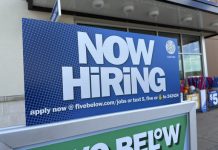WASHINGTON (AP) — U.S. producer prices rose rose in March from a year earlier at the fastest pace in nearly a year, but the gain was less than economists expected. And wholesale inflation eased on a month to month basis.
The Labor Department said Thursday that its producer price index — which measures inflationary pressure before it reaches consumers — rose 2.1% last month from March 2023 , biggest year-over-year jump since April 2023. But economists had forecast a 2.2% increase, according to a survey of forecasters by the data firm FactSet.
And compared to February, wholesale prices were up just 0.2%, down from a 0.6% gain in February and less than the 0.3% uptick economists had expected.
The slightly better-than-expected producer price reading came as something of a relief, arriving a day after the Labor Department reported that consumer price inflation was surprisingly hot last month. Wednesday’s numbers had added to worries that progress against inflation was stalling and raised doubts about when the Federal Reserve will cut interest rates.
Stripping out volatile food and energy prices, so-called core wholesale prices were up 0.2% last month from February, the second straight drop, and 2.4% from March 2023. The year-over-year increase in core producer prices was the most since August. Economists see core inflation as a sign of where overall inflation may be headed.
Wholesale goods prices dipped 0.1% from February, pulled down by a 1.6% drop in energy prices. Services prices were up 0.3% for the second straight month.
In the face of aggressive Fed rate hikes, inflation had fallen steadily after peaking in mid-2022. But the improvements have lately proven harder to come by.
The Labor Department reported Wednesday that its consumer price index was up 3.5% last month from a year earlier, the second straight increase in year-over-year inflation, which remains stuck well above the Fed’s 2% target. Consumer prices were up 0.4% last month from February, matching the January increase. They haven’t fallen on a month-over-month basis since October.
Combating a resurgence of inflation that began in the spring of 2021, the Fed raised its benchmark interest rate 11 times between March 2022 and July 2023, lifting it to a 23-year high. The central bank has signaled that it expects to cut rates three times this year — a reversal in policy that has been eagerly awaited on Wall Street. But inflation’s recent stubbornness has cast doubt on when the rate cuts will start and whether the Fed will really manage to squeeze in three of them this year.
Wall Street investors had originally hoped to see the first rate cut in March. But that didn’t happen, and the inflation numbers have plateaued. Now a majority of investors don’t expect a rate cut until the Fed’s September meeting, according to CME’s FedWatch tool.
George Ball, chairman of the investment firm Sanders Morris, called Thursday’s producer price report “encouraging″ but said ”the Federal Reserve will take its time when it comes to rate cuts.″
Source: post





